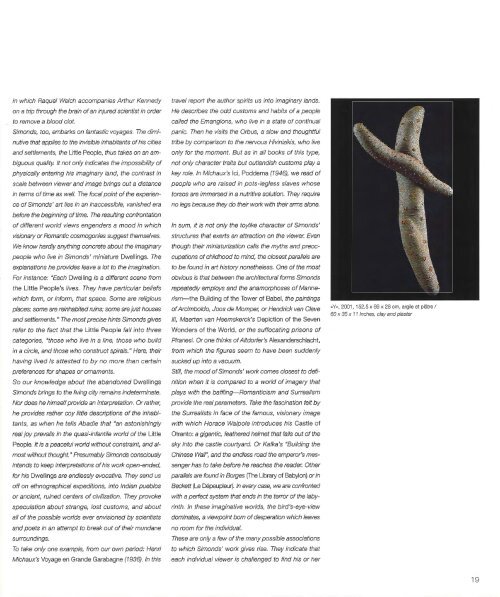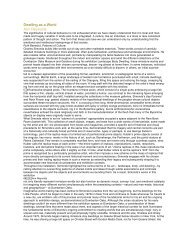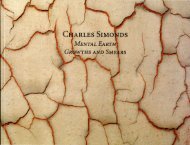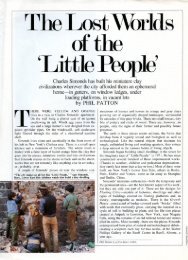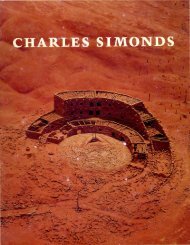in which Raquel Welch accompanies Arthur Kennedyon a trip through the brain of an injured scientist in orderto remove a blood clot.Simonds, too, embarks on fantastic voyages. The diminutivethat applies to the invisible inhabitants of his citiesand settlements, the Little People, thus takes on an ambiguousquality. It not only indicates the impossibility ofphysically entering his imaginary land, the contrast inscale between viewer and image brings out a distancein terms of time as well. The focal point of the experienceof Simonds' art lies in an inaccessible, vanished erabefore the beginning of time. The resulting confrontationof different world views engenders a mood in whichvisionary or Romantic cosmogonies suggest themselves.We know hardly anything concrete about the imaginarypeople who live in Simonds' miniature Dwellings. Theexplanations he provides leave a lot to the imagination.For instance: "Each Dwelling is a different scene fromthe Little People's lives. They have particular beliefswhich form, or inform, that space. Some are religiousplaces; some are reinhabited ruins; some are just housesand settlements. " The most precise hints Simonds givesrefer to the fact that the Little People fall into threecategories, "those who live in a line, those who buildin a circle, and those who construct spirals. " Here, theirhaving lived is attested to by no more than certainpreferences for shapes or ornaments.So our knowledge about the abandoned DwellingsSimonds brings to the living city remains indeterminate.Nor does he himself provide an interpretation. Or rather,he provides rather coy little descriptions of the inhabitants,as when he tells Abadie that "an astonishinglyreal joy prevails in the quasi-infantile world of the LittlePeople. It is a peaceful world without constraint, and almostwithout thought." Presumably Simonds consciouslyintends to keep interpretations of his work open-ended,for his Dwellings are endlessly evocative. They send usoff on ethnographical expeditions, into Indian pueblosor ancient, ruined centers of civilization. They provokespeculation about strange, lost customs, and aboutall of the possible worlds ever envisioned by scientistsand poets in an attempt to break out of their mundanesurroundings.To take only one example, from our own period: HenriMichaux's Voyage en Grande Garabagne (1936)./n thistravel report the author spirits us into imaginary lands.He describes the odd customs and habits of a peoplecalled the Emanglons, who live in a state of continualpanic. Then he visits the Orbus, a slow and thoughtfultribe by comparison to the nervous Hivinizikis, who liveonly for the moment. But as in all books of this type,not only character traits but outlandish customs play akey role. In Michaux's lei, Poddema (1946), we read ofpeople who are raised in pots-legless slaves whosetorsos are immersed in a nutritive solution. They requireno legs because they do their work with their arms alone.In sum, it is not only the toy/ike character of Simonds'structures that exerts an attraction on the viewer. Eventhough their miniaturization calls the myths and preoccupationsof childhood to mind, the closest parallels areto be found in art history nonetheless. One of the mostobvious is that between the architectural forms Simondsrepeatedly employs and the anamorphoses of Mannerism-theBuilding of the Tower of Babel, the paintingsof Arcimboldo, Joos de Momper, or Hendrick van CleveIll, Maerten van Heemskerck's Depiction of the SevenWonders of the World, or the suffocating prisons ofPiranesi. Or one thinks of A!tdorfer's Alexanderschlacht,from which the figures seem to have been suddenlysucked up into a vacuum.Still, the mood of Simonds' work comes closest to definitionwhen it is compared to a world of imagery thatplays with the baffling-Romanticism and Surrealismprovide the real parameters. Take the fascination felt bythe Surrealists in face of the famous, visionary imagewith which Horace Walpole introduces his Castle ofOtranto: a gigantic, feathered helmet that falls out of thesky into the castle courtyard. Or Kafka 's "Building theChinese Wall", and the endless road the emperor's messengerhas to take before he reaches the reader. Otherparallels are found in Borges (The Library of Babylon) or inBeckett (Le Depeupleur). In every case, we are confrontedwith a perfect system that ends in the terror of the labyrinth.In these imaginative worlds, the bird's-eye-viewdominates, a viewpoint born of desperation which leavesno room for the individual.These are only a few of the many possible associationsto which Simonds' work gives rise. They indicate thateach individual viewer is challenged to find his or her. y,, 2001, 152,5 x 89 x 28 em, argile et platre I60 x 35 x 11 inches, clay and plaster19
possibles envisages par les savants et les poetes dansleur desir de s'evader du quotidien.Prenons Ia trilogie Ailleurs d'Henri Michaux, pour ne citerqu'un exemple contemporain. Le recit de Voyage enGrande Garabagne (1936) nous transporte dans descontrees imaginaires. L'auteur decrit les mceurs bizarresdes Emanglons en proie a une panique perpetuelle. Puisil nous emmene chez les Orbus, Ients et poses en comparaisondes Hivinizikis toujours presses, qui vivent dans!'instant present. Comme toujours dans ce genre delivre, les us et coutumes saugrenus sont aussi finementobserves que les traits de caractere. Dans lei, Poddema(1946), Henri Michaux nous parle de gens eleves enpots. Ce sont des esclaves sans jambes dont les torsesbaignent dans une solution nutritive. lis sont reduits al'etat d'hommes troncs parce qu'ils n'ont besoin que deleurs bras pour faire leur travail.Dans les constructions de Charles Simonds, il n'y a pasque l'aspect ludique qui seduise le spectateur. Leur miniaturisationa beau evoquer les mythes de l'enfance,c'est du cote de l'histoire de l'art que l'on trouve lesanalogies les plus tangibles. L'une des plus evidentesrelie les formes architecturales employees par Simondsaux anamorphoses manieristes, a Ia Tour de Babel, auxpeintures d'Arcimboldo, Joos de Momper ou Hendrik IllVan Cleve, a Ia Representation des sept merveillesdu monde de Maerten Van Heemskerck, aux prisonsetouffantes de Piranese ... Ou alors, on songe a uneBataille d'Aiexandre d'Aitdorfer dont les personnagesse seraient soudain volatilises.Cela dit, Ia comparaison avec le registre de l'etrangetedeconcertante donne une idee plus juste de Ia tonalitedes ceuvres de Simonds. Romantisme et surrealisme,voila les vrais parametres. Rappelons-nous l'attirancefascinee des surrealistes pour une image visionnaireprimordiale introduite par Horace Walpole dans LeChateau d'Otrante : le gigantesque casque a plumesqui tombe du ciel pour atterrir dans Ia cour du chateau.Ou La Murail/e de Chine de Franz Kafka, et Ia routeinterminable que le messager de l'empereur doit parcouriravant d'atteindre le lecteur. On pourrait citeraussi Jorge Luis Borges (La Bibliotheque de Babel)et Samuel Beckett (Le Oepeupleur). Chaque fois , nousavons affaire a un systeme parfaitement huile quidebouche sur l'epouvante du labyrinthe. Dans cesunivers imaginaires, c'est Ia perspective a vol d'oiseauqui domine. Elle correspond a une vision desesperee,qui ne laisse aucune place a l'individu.Ce ne sont Ia que quelques-uns des nombreux rapprochementspossibles avec l'ceuvre de Charles Simonds.A chacun de se glisser a sa fac;:on dans les villes et lesepoques disparues de Simonds. A chacun de franchirce pas, seul avec lui-meme. Pour rna part, j'avoue unepreference pour une certaine approche de son ceuvre.Elle Ia relie a La Coupe de Titan de Thomas Cole (1833,The Metropolitan Museum, New York) eta La Ville entii!Jrede Max Ernst, qui temoignent de l'etat du monde avantou apres l'homme, et, par dela, au Henri d'Ofterdingende Novalis, ou un ange emporte le narrateur dans un veritablevol d'oiseau. L'enfant-ange «nous fit voler si hautque Ia terre ressemblait a une coupe doree ornee deciselures infiniment delicates."Cette vision d'une coupe doree, lieu commun du «mondedans le monde•• que l'on retrouve dans La Coupe deTitan onirique de Thomas Cole, designe l'ephemere, ennous invitant a relativiser !'importance de l'histoire del'humanite et de ses reussites. Elle signale une realitefugace dans un univers infini. Car, sur les bords de Iacoupe, il y a des villes et des temples. Des que le titan Iaportera a ses levres, Ia civilisation inconnue qui habiteIa sera prise de panique. L'instant d'apres, elle aura disparu.Ce que nous ressentons devant cette image tresforte nous ramene aux freles evocations de l'ephemereque Simonds nous offre avec chacune de ses villes. Lesconstructions de I' artiste font partie des epiphanies del'art, regies par les seuls principes de surprise et d'indeterminisme.Elles revelent une profonde inquietude,ou les questions existentielles prennent le pas sur toutce que les occupants imaginaires des Dwellings pourraientbien avoir fait ou pense. W. S.Traduit de I' allemand par Jeanne Bouniort20
- Page 2: Galerie Enrico Navarra
- Page 8 and 9: Preface. Enrico NavarraForeword. En
- Page 10 and 11: Le Monde dans le monde. Werner Spie
- Page 12 and 13: of adventures. The Little People we
- Page 14 and 15: eferential microsystems were in wid
- Page 16 and 17: •LandscapeBodyDwellin9", 1970Char
- Page 20 and 21: •Picaresque Landscape•, 1976, i
- Page 22: I Remember... Jean-Louis PratI reme
- Page 26 and 27: Ritual Place, 1970Argile et bois13
- Page 28 and 29: Labyrinth, 1972Argile et bois30x63x
- Page 31: 32Pyramid, detail I detail, 1972
- Page 34 and 35: elieved in a world entirelywould be
- Page 36 and 37: Circles and Towers Growingno11, 197
- Page 39: Dwelling, details, 1981Argile et bo
- Page 44 and 45: Age, 1983Argile, platre et bois310
- Page 47 and 48: Flying Smear, 1983Argile, bois et p
- Page 49 and 50: Wilted Towers, 1984Argile et bois30
- Page 53 and 54: Rocks no 1 , 1984Rocks No. 1, 1984T
- Page 55 and 56: Stump, 1984Argile et bois35,5 x 61
- Page 57 and 58: Pod no 2, 1984Argile et bois29,2 x
- Page 60 and 61: Leaves, 1986Argile et bois15x61 x61
- Page 62 and 63: Smear, 1986Argile et bois15,2 x 76,
- Page 66: Rocks, 1988Rocks, 1988Spirit Rocks,
- Page 69 and 70:
Pyramid, 1991Argile, platre et bois
- Page 71 and 72:
Dwelling, 1991Argile et boisBriques
- Page 73 and 74:
Head, 1993Argile, platre et bois67,
- Page 75 and 76:
Tumbleweed, 1993Porcelaine20,5 x 20
- Page 77 and 78:
I, Thou, 1993Argile et ciment37,5x2
- Page 79 and 80:
Man and Fish, 1993Argile et bois25
- Page 82:
82Growth House, detail I detail, 19
- Page 85 and 86:
Maze, 1998 Maze, 1998Argile et bois
- Page 87 and 88:
Houseplant no 2, 1998Houseplant No.
- Page 90 and 91:
Long Rocks, 2000Argile, platre et s
- Page 92:
Sans titre, 2001Argile. platre et t
- Page 98 and 99:
Charles Simonds, 1950 «Rabbit Read
- Page 100 and 101:
Greene Street Dwelling, New York, 1
- Page 102 and 103:
••Excavated and Inhabited Railr
- Page 104 and 105:
Charles Simonds travaillant I worki
- Page 106 and 107:
«Dwelling•, Whitney Museum, New
- Page 108 and 109:
Desert en fleur, Nouveau-Mexique I
- Page 110 and 111:
Travaillant sur «Age .. I Working
- Page 112 and 113:
«Passage .. , 1989, Centre Georges
- Page 116 and 117:
Expositions I ExhibitionsExposition
- Page 118 and 119:
-"9th Biennale de Paris", Musee d'A
- Page 120 and 121:
charles simondsSculpture Since 1940
- Page 122 and 123:
Simonds), Cologne, Germany, Verlag
- Page 124 and 125:
Kind, Joshua- "Charles Simonds: An
- Page 126 and 127:
125
- Page 128:
Edite par I Published by: Galerie E


